From the eerie absence of birdsong to green shoots sprouting from burnt-out trees, Guardian readers in Australia have shared their stories and pictures of nature in the aftermath of the country’s devastating bushfires.
‘The utter silence left a deep impression’
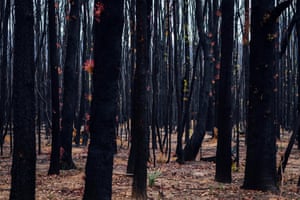
I went for a drive out to Tallowa Dam as I heard the fires had been bad there. Bad doesn’t even begin to describe the utter devastation. Melted road signs, split rocks and skeletons told me that for a few days this was literally hell on Earth. However, the speed and force with which the regrowth had commenced was breathtaking and the way that some shoots burst through scorched trunks reminded me of childbirth. There were shoots emanating from everywhere – and quickly. The deepest impression I was left with, though, was the utter silence. Australian bush is usually a riot of noise. I could just hear the trickle of water and the odd insect, and I saw no marsupial life at all.
Simon Ross, Redfern, Sydney, New South Wales
Q&A What is the After the Bushfires series?
Show
Hide
The wildfires that swept through many parts of Australia between July 2019 and February 2020 were of a scale and size that is difficult to imagine. By the end of February, they had burned through at least 32,000 square miles (85,000 sq km) of Australian forest, an area the size of Ireland.
Nearly 3 billion animals were killed or displaced by bushfire. The habitat of an estimated 143 million mammals, 180 million birds, 51 million frogs and 2.5 billion reptiles was burned.
The fires came during Australia’s hottest year on record and in a country that already has among the world’s highest extinction rates because of invasive non-native species such as cats, foxes, deer, horses and various pathogens, along with habitat clearing and fragmentation.
But one year on from the start of those fires, what does the landscape look like today? With state borders closing because of Covid-19, the Guardian took a virtual journey through the blackened path of Australia’s summer of bushfires, talking to those who are investigating the state of the continent’s surviving flora and fauna.
‘Tragic and yet hauntingly beautiful’
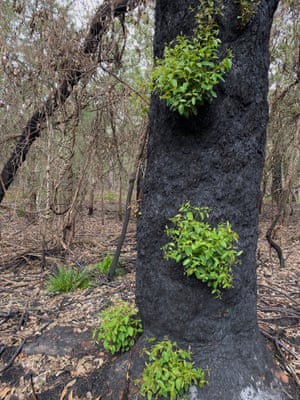
In late February, we came back to camp at our “special place” at Lake Conjola. It was shocking and I was conflicted in my response to the devastation – the sight of all the dead, lifeless trees was tragic and yet hauntingly beautiful. l will never forget the smell – it was like burnt toast, only worse. There are signs of life around the lake. The undergrowth is starting to shoot and most of the trees look a bit dishevelled and not their best – as if they are still in their pyjamas, with frilly green shoots sprouting up and down their bodies.
Vyvian Wilson, Wombarra, New South Wales
‘Green shoots were appearing everywhere’
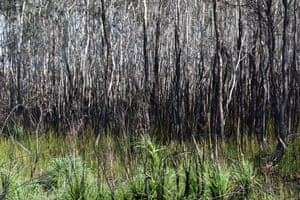
This photo was taken five weeks after the bushfires that started on 9 September, forcing hundreds of residents to evacuate. I was amazed at how within a few short weeks and some heavy rain, fresh green shoots started appearing everywhere in front and below the burnt-out woodland. I wanted to capture this particular image as it tells the story of the power of nature to rejuvenate so quickly after a disaster. At the time of taking this shot there was still an eerie silence in the burnt areas, normally full of birdsong.
Ingrid, Peregian Beach, Queensland
‘The ground resembled a giant slag heap’
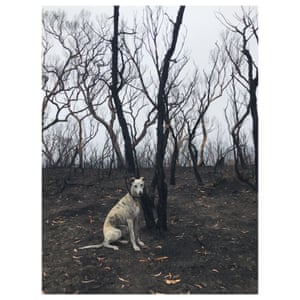
En route to Mount Wilson on 11 January, I stopped to take in a small portion of the damage. It was a misty, cold morning for January, silent, with no signs of life. My dog Finn trod nervously on the embers. The raw smell hurt my nose and made my eyes water; it must have been a strange experience for him. The ground resembled a giant slag heap with ghostly remains of trees. There were no insects or birds. The only colour apart from black, brown or grey was the occasional faint hint of green from the bases of ferns where new shoots were emerging. The regrowth is great, but the science reminds us diversity will not return.
Patrick Manley, Manly, New South Wales
‘Not even an ant or a spider’
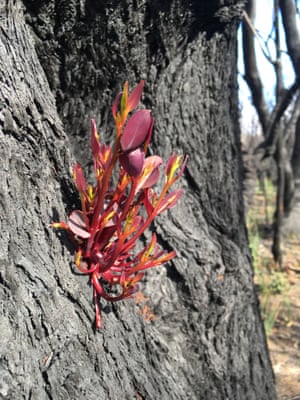
A good friend and I recently spent a day in the Blue Mountains, off-track. Small signs of renewal were everywhere – shoots on charcoaled trees, thick ground cover in gullies and knee-high grasses in places where – without the fires – passage would have been difficult at best. We saw no animals or insects. Not even an ant or a spider. We heard only some birds near watercourses, though we spotted animal prints in some muddy slopes, thick with blackened, rotting vegetation. The fires have made it possible to see unusually far into the otherwise very dense bush. It was very quiet. Spending a few hours in the bush worked wonders for our mental health, what with 2020 being what it is.
Patrick, Kirrawee, New South Wales
‘It feels sacred out here’
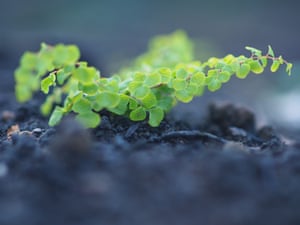
This is Sarsfield, where I’ve walked for almost 40 years. The grieving for me is the clash between the memory of who I should meet when I go (lyrebirds, treecreepers, yellow-bellied gliders) and the harsh, silent reality confounding my senses. The landforms, hills and gullies, and where the water needs to flow, are laid bare. The silence is hard to take. My ears still ring with expectation but in secret gullies, the rain on the ash is enabling the most exquisite growth. Ancient plants that grow from spores are springing up. It feels sacred out here.
Hilary Stripp, East Gippsland, Victoria
‘The sight of the baby wrens was joyful’
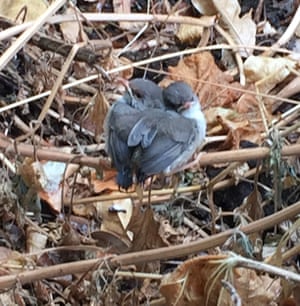
I nearly trod on these two baby blue wrens in a singed patch of garden when I was starting to clean up. They must have hatched at around the time of the Cudlee Creek fires in the Adelaide Hills last December and the sight of them was the most joyful thing I had seen since. Fortunately, I noticed them in time. They and their family survived the inferno and the barren aftermath and are now flitting around recovering in the garden. They’re like little mice with wings – tiny, always vigilant and mostly on the move. Since the fire I have been feeding them, as well as the local magpies and firetail finches. Their growth has been mirrored in the garden, as much (but not all of it) has revived and recovered. It has been a privilege and joy to see those tiny birds survive to adulthood.
Felicia Bulman, Woodside, Adelaide Hills, South Australia
‘A stark demonstration of climate-driven change’
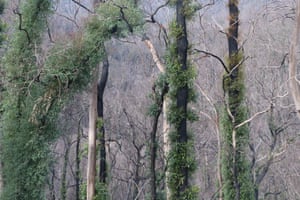
We drove along the Kings Highway today. Having seen the extent of the damage along the coast, we believed ourselves immune to further shock. We knew that large inland areas had been severely burnt but knowing something and seeing it are very different things. Change is eternal. Nothing ever goes back to what it was. How much what returns will resemble what existed before is unknowable and this is very likely only a beginning. Even after this stark demonstration of the reality of climate change and the incredible difficulties it is likely to create for future generations, our leaders cling to fossil fuels. We are at the beginning of a long era of climate-driven change. This is now a simple fact.
Laurie, Ulladulla, New South Wales
‘The echidnas made our hearts soar’
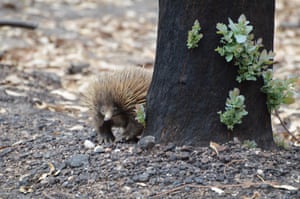
In the early weeks of Humane Society International’s search and rescue efforts on Kangaroo Island we saw very little live or healthy wildlife. The death and suffering was extremely confronting, but every couple of days we seemed to come across an echidna wandering through the plantations, seemingly without a care in the world, and it never failed to make our hearts soar. Echidnas are incredibly well adapted to fires and their aftermath. Their strong limbs and backward facing hind feet mean they can dig straight down and deal with obstacles rapidly. Tolerance to high carbon dioxide and low oxygen levels means they can hunker down breathing through the soil until they’re safe. They then use torpor to reduce their energy requirements and activity in a post-fire landscape.
Evan Quartermain, Sydney, New South Wales
‘The parrots are fewer and the owls are gone’
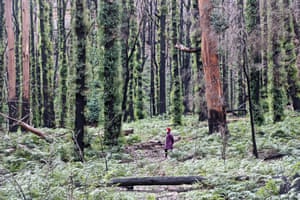
A fire raged through this beautiful valley at the southern end of the Newnes Plateau near Lithgow in December. We have been visiting this place for 30 years and are heartbroken to see it so diminished from its pristine state. The bush is struggling to recover – it is mainly bracken, grasses and ferns growing back. We have had two hot burns in six years, and have lost all the old-growth trees. What I notice most is that many birds leave and are slow to return as the tree canopy is gone. There are still white cockatoos and occasionally black cockatoos but the parrots are fewer and the owls have gone. The smaller birds like wrens and honeyeaters also leave, as the understory where they usually dart about has disappeared. Last time we visited, there were lots of kangaroos on the way into the valley as the grass is now plentiful. I think there are wombats as well because I have seen their scat. That’s good to see.
Gina Richter, Sydney, New South Wales
‘The colour scheme is slowly shifting from ash grey’
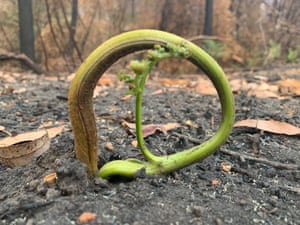
I drove through Club Terrace, in Victoria, four to five weeks after the fires, when the roads opened, and the landscape looked like a wasteland. Canopies and undergrowth were all gone, and you could see for miles through the (seemingly) dead husks of trees. Six months later, the landscape is unrecognisable. In a good way. The ferns are back, sprouting out of the blackened earth and trunks and the ground is once again blanketed in moss, shrubs and native grasses. This shoot (above) is called a male fern. The colour scheme is slowly shifting from ash grey, black and brown to the full spectrum of greens that I’ve always associated with that part of the world. It’s incredible how quickly it has bounced back – a testament to nature’s resilience. Though I’m sure much of it is superficial. It must take years for the ecosystem to truly recover.
George Boyer, Melbourne, Victoria
Find more age of extinction coverage here, and follow biodiversity reporters Phoebe Weston and Patrick Greenfield on Twitter for all the latest news and features